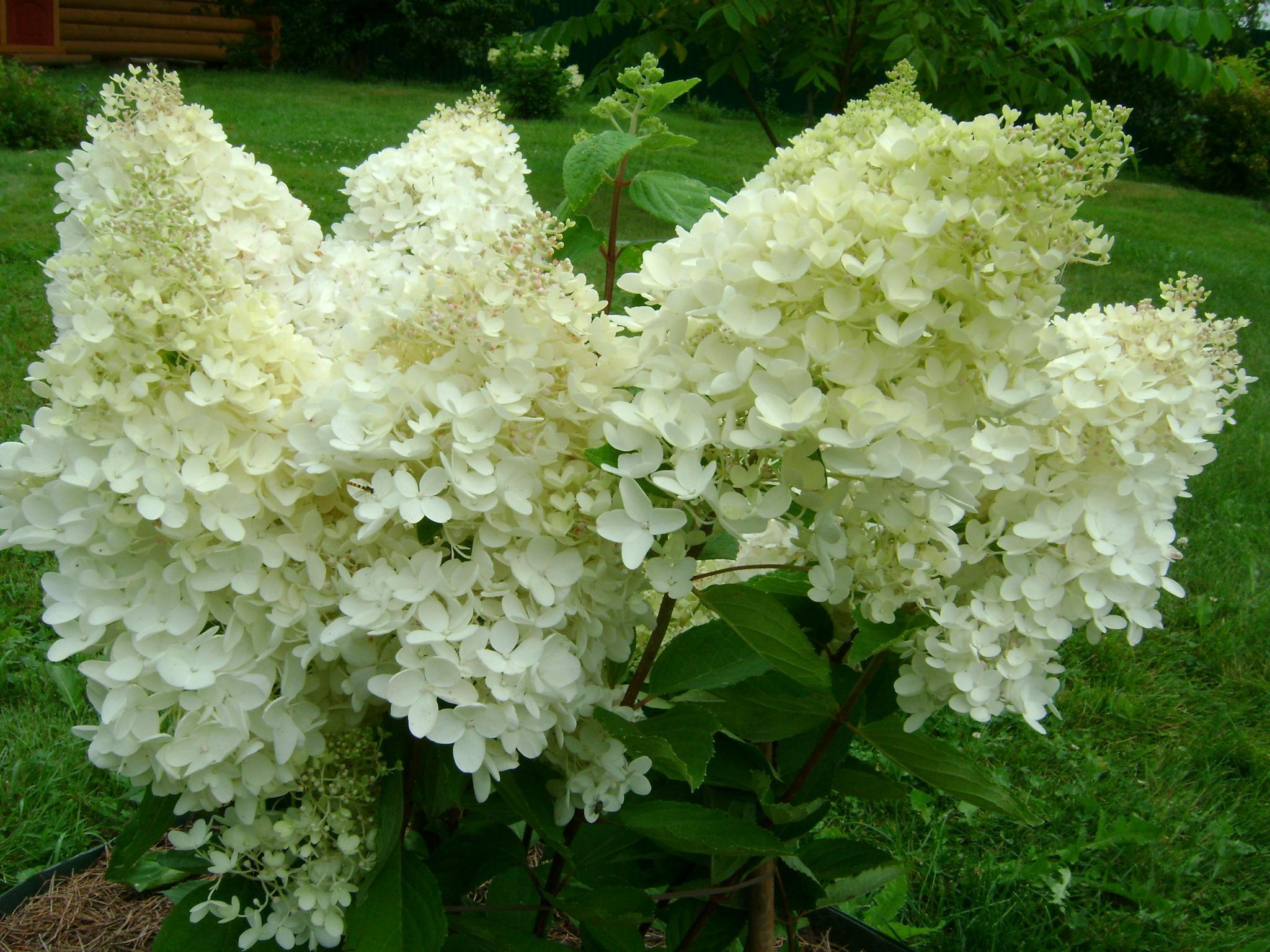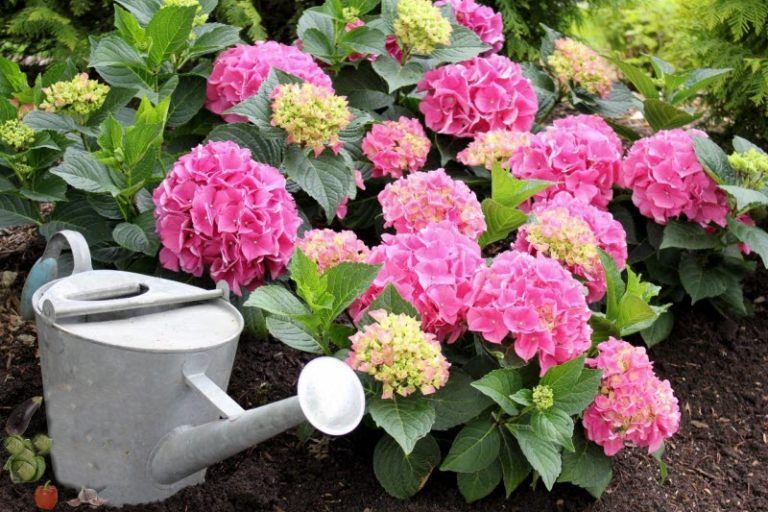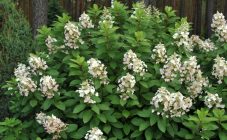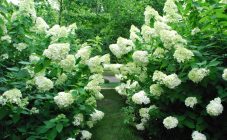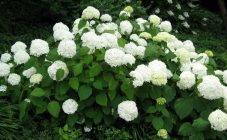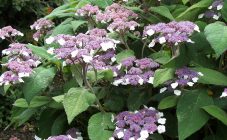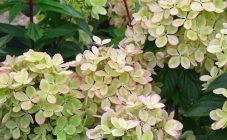Content:
The historical homeland of hydrangea paniculata Dentel de Gorron is Asia. In the wild, it can be found in some regions, including: China, the Japanese and Kuril Islands, Sakhalin. The height of shrubs growing in natural conditions reaches 4 meters.
Hydrangea is able to bloom magnificently only in conditions of proper care.
Description of hydrangea Dentelle de Gorron
Hydrangea Dentelle de Gorron, intended for cultivation in a temperate climatic zone, does not grow above the two-meter mark. The shape of the inflorescence is cone-shaped, the diameter is 38 cm.The color is presented:
- snow-white;
- light green;
- light pink;
- cream;
- dark pink color variations.
The leaf has a bright color, an oblong pointed shape.
The similarity between the garden and paniculate varieties is the change in color during the transition to the next phase of development. In the winter season, the inflorescences continue to cover the shrub - the flowers covered with snow perfectly complement the design of the garden area.
Varietal varieties of hydrangeas
At the end of the summer season and in the first weeks of autumn, varieties with pink flowers look especially attractive on a personal plot. Turning pink, inflorescences can acquire both a dark shade and a red or rust color.
However, white and green varieties are considered popular and in demand among amateur gardeners. Some of them are presented below.
- Magical Moonlight variety differs in the large size of inflorescences of a snow-white shade with a shrub height of one and a half meters. At the end of flowering, the bush turns pink. The forty-centimeter inflorescences of the variety are distinguished by a transition from greenish to white.
- Silver Dollar grade retains a snow-white hue throughout the entire flowering phase.
- Shrub hydrangea Unique differs in the dark color of the leaves and white flowers with a pinkish tint.
The green shade of flowers is considered non-standard for plants, but it is characteristic of the flowering phase, after which they can turn both white and pink. The list of varieties with green flowers also includes: Candlelight, Limelight, Little Lime Jane, Diamantino.
Ornamental planting with hydrangea
By placing the panicle hydrangea on the most favorable background, the gardener will ensure that the appearance of the shrub becomes even more attractive. A good combination is achieved when planted next to trees or flower shrubs such as Canadian hemlock, tulip liriodendron, yew, scumpia, birch or boxwood.
The following types of flowering perennials can be planted in a flower bed with a hydrangea bush:
- phlox paniculata;
- astilba;
- Japanese anemone.
Looks great under the hydrangea:
- host;
- mountain women;
- creeping tenacious;
- flowers of decorative onion plantings.
You can dilute the design composition with the following types of ornamental herbs:
- fox-tailed pinnacle;
- miscanthus;
- impera Red Baron or sedge.
Growing hydrangeas
Temperature regime
The hydrangea variety Dentel de Gorron is a seasonal plant, which suggests that it needs a dormant period. The resting phase of the plant consists in partial or complete cessation of development, inability to form flowering shoots. This feature should be taken into account when growing hydrangea at home or apartment conditions. The reason for the absence of inflorescences may be the presence of the bush in the dormant stage.
The minimum temperature, which is not harmful to plant health, is -8 ° C. In a snowless winter, hydrangea is able to withstand temperatures down to -20 ° C if the decrease is short-lived. As a medium cold hardy hydrangea, Dentel de Gorron must be covered for the entire winter season. Each elongated shoot must be bent to the ground, covered with spruce branches or covering material.
If we talk about hydrangeas in general, their frost resistance is different. Some varietal varieties freeze at a temperature of -4 ° C of air, and species like panicle hydrangea are able to withstand -40 ° C.
Of all the existing varieties of decorative purposes, the most commonly grown is large-leaved. However, this variation of hydrangea is considered the most demanding in terms of temperature. Breeders have specially bred varieties that are resistant to cold snaps, however, they must be closed in the winter season.
In conditions of an extremely hot summer, foliage and buds often fall off the hydrangea. The normal temperature regime for growing this plant is + 22 ° C. If this value is exceeded, the plant needs to be shaded, watered more often.
Light mode
Plantings of hydrangeas of all types should be abundantly lit. However, cultivation in partial shade conditions is also allowed. However, direct sunlight should be avoided. Foliage can get burned when exposed to the summer afternoon sun.
You can also plant a flower next to a residential building. With this option for the location of the ornamental bush, it is recommended to choose a site where, when planting, most of the sun's rays can reach the plant in the morning or evening time of the day, but not at noon.
When growing hydrangea in the summer on the southern windowsill, you should take care of shading. A transparent curtain is suitable for this purpose. Breeding this plant in the summer in a greenhouse, a special mesh is pulled over the bush, and the glass is whitened with a solution of lime.
Preparing the soil substrate
You can achieve good results when breeding hydrangeas by preparing the required soil composition for planting. Hydrangea can grow normally, develop well and bloom profusely only when grown in a substrate enriched with useful substances, which has a loose, but not sandy, structure. In this case, the liquid will go deep without lingering in the area of the root system.
Hydrangea develops well if microscopic fungi are present in the soil composition that live in the earth with an increased acid reaction. In this case, the acidity should not exceed 7.
How to properly water hydrangea
Carrying out irrigation activities has some features:
- should not be watered with water of excessively low temperature;
- when irrigated with too hard water, there is a possibility of a change in the alkaline composition of the soil towards neutralization or excessive alkalization;
- watering with stagnant water can lead to decay of the root system;
- irrigation activities should not occur at a time of increased solar activity;
- when watering, avoid getting water on foliage and buds;
- due to the excessively high chlorine content, the use of tap water for watering hydrangeas is unacceptable.
The presence of a mulch layer will eliminate the need for frequent watering. The list of recommended materials for creating mulch includes:
- hay;
- chopped straw;
- sawdust;
- coniferous needles.
Early spring is considered the most suitable time for mulching.
In autumn, the land can be mulched again. When grown indoors, the amount of watering is reduced when the air temperature drops.
How to fertilize hydrangea correctly
Fertilization has a positive effect on the appearance of the decorative planting and helps to form large inflorescences. For adult plants, both organic and mineral compositions are used.
The early spring period is considered the start time of top dressing. Complex liquid fertilizer in the form of a solution of potassium sulfate and superphosphate is applied by irrigation. Organic application is carried out in a week.
Nitrogen-containing fertilizers are added exclusively in the early spring period.
Reproduction of hydrangea
Cuttings for cultivation are taken in the summer before the flowering and budding of the plant.
From the shoot 10 cm long, the lower leaves are removed, and the upper ones are shortened by half.
A plastic bottle placed on top will serve as a greenhouse. Once located in a shaded area, water the planting daily.
Knowing how to properly grow and propagate a hydrangea, you can create a gorgeous flower bed on your garden plot, which will smell and delight the owner with lush flowering.
